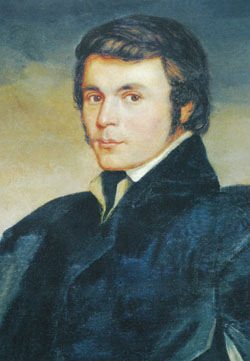An educator and an advocate for modernization, Khachatur Abovian is reputed as the father of modern Armenian literature and best remembered for his novel Wounds of Armenia, but also for his mysterious disappearance at the age of thirty-nine.
He was born on October 15, 1809, in the village of Kanaker, now a district of Yerevan. His family were descendants of the Beglarian family of meliks in Gulistan, one of five Armenian families who ruled around in Artsakh (Gharabagh). The Abovian family held the position of tanuter (տանուտէր, lordship) in Kanaker and his uncle was the last one.
At age ten, the future writer was taken by his father to Echmiadzin to study for priesthood. He dropped out after three years and moved to Tiflis in 1822 to study at the Nersisian School. Abovian graduated in 1826, but the outbreak of the Russo-Persian war (1826-1828) curtailed his plans to further his education. For the following three years, he taught briefly at the monastery of Sanahin and then worked for Catholicos of All Armenians Yeprem I (1809-1830) as his clerk and translator. While working at Holy Echmiadzin, twenty-year-old Abovian met many notable foreigners, including Russian diplomat and playwright Alexander Griboyedov, who was stuck in Echmiadzin en route to Tabriz in 1828.
Abovian’s life had a turning point with the arrival of Friedrich Parrot, a professor of philosophy from the University of Dorpat (Tartu, present-day Estonia) in September 1829. Parrot traveled to Armenia to climb Mount Ararat to conduct geological studies. He required a local guide and a translator, and the Catholicos assigned Abovian to these tasks. With his assistance, Parrot became the first explorer in modern times to reach the summit of Mount Ararat on their third attempt on October 9, 1829. Abovian would climb the mountain again in 1845 with German mineralogist Otto von Abich and in 1846 with Englishman Henry Danby Seymour.
Impressed with Abovian’s thirst for knowledge, Parrot arranged for a Russian state scholarship for him to study at Dorpat. He entered directly to the philosophy branch of the Philological-Historical department from 1830-1836. He studied social and natural sciences, European literature and philosophy, and mastered German, Russian, French and Latin.
In 1836, he returned home anxious to embark on a mission of enlightenment, but his efforts were thwarted by the growing and hostile reaction from the Armenian clergy as well as Tsarist officials, largely derived from his opposition to dogmatism and formalism in the school system.
Abovian was appointed as the supervisor of the Tiflis district school and married a German woman named Emilia Looze in 1839. They had two children, Vardan and Zarmandukht (Adelaide). He was dismissed from the school in 1843 and transferred to the district school in Yerevan where he encountered apathy and antagonism from his colleagues and the clergy.
Abovian wrote novels, stories, descriptions, plays, scientific and artistic compositions, poems, and fables. He was the first Armenian writer to compose literature for children. His most important work was the historical novel Wounds of Armenia (written in 1841, but first published in 1858), which was the first Armenian secular novel dedicated to the fate of the Armenian people and its struggle for liberation in the period of the Russo-Persian war. The novel dealt with the suffering of Armenians under Persian occupation. Its basic concept was the assertion of feelings of national merit, patriotism and hatred of oppressors. These themes had a deep influence over wide layers of Armenian society. The hero, Aghasi, personifies the freedom-loving national spirit and its will to fight against the foreign conquerors.
Abovian saw a guarantee of the national, political and cultural revival of his native lands in the strengthening of Russian-Armenian friendship. This is a stance that was overemphasized during Soviet rule. However, he was already disillusioned with Tsarist policies in Armenia, particularly with the implementation of the Polozhenie (Statute) in 1836, which greatly reduced the political power of the Armenian Church, and the abolishment of the Armenian Province in 1840.
In July 1843, he accompanied Moritz Wagner, a professor from the University of Munich, on the first recorded ascent of Mount Aragatz. In August, he escorted German Baron August von Haxthausen around Armenia. In 1845, he applied for a position at the Catholicosate but was not accepted.
On April 14, 1848, Abovian left his home for an early morning walk, and was never seen again; his disappearance remains unresolved. Numerous theories have been proposed, including that he committed suicide, was murdered by Persian or Turkish enemies, or arrested and exiled to Siberia by the Czarist secret police, among others.
Abovian is well remembered in Armenia, with schools, streets, boulevards and parks named after him, and two prominent statues in Yerevan. The village of Elar, six miles northeast of Yerevan, was named after him in 1961 and later received city status. Abovian’s home in Kanaker has become a house-museum and the Pedagogical University of Yerevan is named after him.
